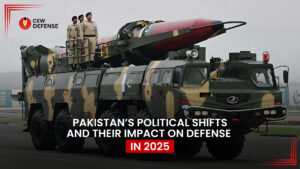Background
Nuclear deterrence is the strategy of preventing conflict by threatening devastating nuclear retaliation. In South Asia, this concept is crucial because India and Pakistan, two neighboring countries with a history of conflict, both possess nuclear weapons.
India conducted its first nuclear test, called “Smiling Buddha,” in 1974. Pakistan, feeling threatened, accelerated its nuclear weapons program and officially became a nuclear power in 1998 after conducting its own nuclear tests shortly after India’s tests the same year.
According to the Stockholm International Peace Research Institute (SIPRI) and the Federation of American Scientists (FAS), both India and Pakistan currently have approximately 160 to 170 nuclear warheads each.
These arsenals are maintained to preserve strategic stability based on the principle of mutually assured destruction (MAD), which means both sides understand that using nuclear weapons would lead to their own destruction as well. This article explores how nuclear deterrence in South Asia, particularly the India-Pakistan nuclear conflict, balances regional stability and increasing risks of escalation.
The Problem
Despite the deterrent effect of nuclear weapons, the South Asian security environment remains highly volatile. India and Pakistan have fought multiple wars, including the Kargil War in 1999, which was the first conflict between the two countries after both had declared themselves nuclear powers. This conflict tested the limits of nuclear deterrence, showing that while nuclear weapons may prevent full-scale wars, they do not eliminate the risk of limited conflicts escalating dangerously.
The ongoing dispute over Kashmir remains the central source of tension. The Kashmir dispute remains a flashpoint for potential nuclear miscalculation between India and Pakistan, especially during times of military escalation. Domestic politics in both countries also influence nuclear postures. For example, nationalist sentiments often intensify during elections or political crises, leading to more aggressive rhetoric and military posturing.
The revocation of Jammu and Kashmir’s special status by India in 2019 heightened tensions and increased military alertness. Similarly, political leaders in Pakistan sometimes use strong anti-India rhetoric to consolidate support, which can complicate efforts to maintain nuclear stability.
Stability and Risk
Stability
Nuclear weapons have arguably prevented large-scale wars since 1998 by creating a balance of power. Both India and Pakistan understand that nuclear conflict would cause catastrophic consequences, which acts as a strong deterrent.
Risk
The risk arises from differences in nuclear doctrines and the evolving nature of warfare. India follows a “No First Use” (NFU) policy, pledging not to use nuclear weapons unless first attacked by nuclear weapons. Pakistan rejects NFU, arguing that such a policy would weaken its deterrent given India’s conventional military superiority. This ambiguity introduces uncertainty, increasing tensions during crises.
Both countries continue to develop new delivery systems. For example, Pakistan has deployed tactical nuclear weapons like the Nasr missile, a short-range missile with a range of about 60 kilometers designed for battlefield use. Tactical nuclear weapons lower the threshold for nuclear use and complicate deterrence. India has developed advanced delivery systems such as the BrahMos missile, a supersonic cruise missile capable of carrying conventional or nuclear warheads, enhancing India’s strike capabilities.
External Influences
The regional nuclear balance is also shaped by external actors:
United States
The US-India Civil Nuclear Agreement of 2008 marked a significant shift. It allowed India access to nuclear technology and fuel despite India not being a signatory to the Nuclear Non-Proliferation Treaty (NPT). This deal strengthened India’s strategic position and deepened US-India ties, which some analysts argue has contributed to Pakistan’s sense of insecurity and accelerated its nuclear developments.
China
China is a close ally and strategic partner of Pakistan. It has provided Pakistan with missile technology and nuclear assistance, enhancing Pakistan’s deterrent capabilities. China’s own nuclear modernization and assertive regional posture further complicate South Asia’s security environment.
Future Risks: Emerging Technologies
The future of nuclear deterrence in South Asia will be influenced by new technologies that could undermine existing command and control systems:
Cyber Warfare
Cyberattacks could target nuclear communication networks, early warning systems, or missile launch controls. Such attacks risk causing false alarms or disrupting decision-making during crises, potentially leading to accidental escalation.
Artificial Intelligence (AI)
AI may automate parts of nuclear command chains or be integrated into missile defense systems. While these technologies can improve response times, they also increase the risk of misinterpretation or accidental launches if not carefully managed.
These emerging threats add complexity to an already fragile balance and require India and Pakistan to adapt their deterrence strategies accordingly.
What Can Be Done?
To maintain regional stability and reduce risks, several measures are essential:
- Establish reliable communication channels and crisis management protocols to prevent misunderstandings during tense situations.
- Promote confidence-building measures such as transparency in military exercises and nuclear doctrines.
- Encourage dialogue to clarify nuclear policies and reduce ambiguity, especially regarding Pakistan’s stance on NFU.
- Support arms control initiatives to limit the development and deployment of new nuclear weapons and delivery systems.
- Encourage diplomatic efforts to resolve long-standing conflicts, particularly over Kashmir.
Conclusion
Nuclear deterrence in South Asia remains a delicate balance between maintaining peace and managing significant risks. Both India and Pakistan maintain nuclear arsenals aimed at preserving strategic stability through mutually assured destruction. However, differences in doctrine, ongoing conflicts, domestic political pressures, and external influences create a fragile equilibrium.
Looking ahead, emerging technologies such as cyber warfare and artificial intelligence pose new challenges to nuclear stability by potentially undermining command and control systems. It is imperative that India, Pakistan, and the international community work together to enhance communication, transparency, and conflict resolution to ensure that nuclear deterrence continues to serve as a tool for peace rather than a trigger for disaster.







